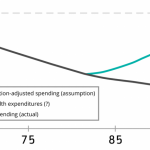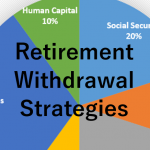Where do you get your Income in Retirement?
Now that we understand a little better what expenses are going to be in retirement, how do you replace your paycheck and pay for all of those expenses? And where does that income come from?
Retirement planning is sometimes called retirement income planning, because retirement is all about turning assets into income. The goal is to get money into your checking account automatically once or twice a month, as this simulates paychecks most are familiar with while you are working.
On the other hand, you know you need a cash reserve, so you might be better off just continuously spending from your 2-3-year cash reserve, and then refilling that bucket once or twice a year.
So, regardless if you want cash to drop in your checking account twice a week or twice a year, where does that cash come from? How do you manage retirement withdrawals in a tax-efficient manner, and in a way that mitigates the known risks of retirement?
Which Assets Provide Retirement Income?
Which asset should you access (and when) to reduce taxes and improve overall retirement security? This is important, as we all have different sources of retirement income and different products to consider. Most of us have social security, pre-tax retirement plans and home equity, while fewer of us have pensions or annuities. Let’s look at withdrawal strategies in retirement designed to minimize taxes and maximize income, and then discuss some features of various assets that affect how you manage your retirement withdrawals.
Guaranteed vs Variable Income Sources
Once we understand that retirement is all about spending, we need to next consider the two different sources of income. The first are the “guaranteed” lifelong sources of income, such as social security, pensions, and income annuities. These can floor your income; that is, provide a steady source for your needs during retirement. Some like to have all of their necessary expenses in retirement covered with these steady sources of retirement income. Other sources of income, such as business and rental income may also be more or less continuous streams of income.
Next, you have your investment assets such as stocks and bonds. These provide a variable source of income and are best suited to provide for your wants.
How to Create Retirement Income
Once you know your yearly expenses, break them down into monthly expenses. Then, take that amount and subtract out your income from stable sources (social security, pension, and annuity). The difference you are left over is the amount to cover from your yearly cash account. This is the amount you need to have 2-3 times in cash.
Withdrawal Sequencing: Account Selection
In general, the retirement strategy for withdrawal sequencing follows a staged approach. Most commonly, you spend first from a brokerage account, and then tax-deferred money. Finally, utilize tax-free (Roth) assets. This sequence is an optimal retirement strategy as it allows tax-sheltered accounts to grow while spending down the taxable accounts. Spending taxable money first decreases taxes (via less tax drag), because as you spend it down, there is less to tax!
Aside: Tax Drag
Money in your taxable brokerage account is subject to yearly taxation. If you are invested in equities, you will pay capital gains taxes on the dividends. For cash and bonds, you pay ordinary taxes on your interest. When possible, it is optimal to have money in tax-deferred accounts such as retirement and Roth accounts because these grow without yearly tax drag.
Caveats to Withdrawal Sequencing
So, it is most common to pull money out of your brokerage account and cash reserves early in retirement. This reduces tax drag. However, it is important to remember you should pull out at least enough money from your tax-deferred retirement accounts every year to fill up your standard deduction and lower tax brackets. Again, the goal is to smooth out the total taxes you pay over your retirement. In general: pay taxes later, except when you can pay them now for less.
Instead of the withdrawal sequence brokerage first, then pre-tax, then tax free, often times withdrawing from pre-tax accounts before you are forced to do so makes sense. This saves your brokerage account from being decimated, and importantly, decrease the sum of total taxes you pay over your lifetime.
Don’t forget that your retirement plan may call for Roth conversions. These Roth conversions will fill up your lower tax brackets as well.
Roth First?
Conversely, there may be years where you want to access Roth account as well. In a pinch, you can use the money in the Roth account to fill up your cash bucket and not suffer tax consequences. So, say for example you have a significant expense that drains your reserves. Instead of selling from your brokerage account and paying capital gains, sometimes the best options is to take the tax-free money from the Roth account. This does not spike your taxes as would a withdrawal from a pre-tax retirement account. This can be especially important when we consider IRMAA planning, as is discussed later.
Sources of Income in Retirement
Let’s talk in detail about some of the sources of income in retirement that need to be considered.
Retirement accounts –
IRAs and 401k or 403b plans usually represent a large portion of the nest egg for those who were employed. This money is a ticking tax bomb and must be addressed early in the planning process. Taking this money tax efficiently is a large component of tax minimization.
Atypical Retirement Accounts –
Think about non-governmental 457 plans and other non-qualified retirement accounts here. These plans may have unique distribution options that affect all other parts of the withdrawal plan. Inherited IRAs now fall in this category as the SECURE Act now forces a maximal 10-year distribution.
Social Security –
This is not a major source of income for high net worth folks, but planning is important none-the-less. If you are married, the highest earner must defer social security to get the maximal COLA-adjusted life-long guaranteed longevity insurance check for the surviving spouse.
Brokerage Accounts –
Tax efficient asset location and capital gains planning are important considerations in your brokerage account. More on these topics later.
Pensions –
These are wonderful aside from being fully taxable, which has significant implications. While income streams are always great, they essentially assure you will be in higher tax brackets in your retirement.
Rent or Royalty –
Or other sources of “passive income.”
Inheritance –
Don’t plan on inheritance in your retirement strategy. Sure, death is the only real guarantee in life. But perhaps only insurance companies and mortuaries should depend on death for income.
Annuities –
See Separate chapter
Part-time Work –
Human capital is an important part of retirement. Many folks enjoy the social interaction you get with part-time work. Even a small amount of income early on can mitigate known retirement risks, let alone have a positive effect on retirement satisfaction.
Home Equity –
Believe it or not, even the wealthy may have indications for a Reverse Mortgage. More later in a separate chapter.
So, you have many sources of income to draw on. The key is to get them all working in symphony in a tax-efficient manor such that they optimally provide income with the least expense due through taxation.
So, How do you Create Retirement Income?
In summary, you create retirement income by funding your cash reserves once a year. Then you spend this down over the course of the year. You can have money funneled into the checking account every two weeks or once a month, just like a paycheck.
Remember, you only need to have cash reserves to cover the spending that is not covered by your guaranteed sources of income.
Then, once a year as you rebalance your accounts, you can pull money from your investments and refill you cash buffer. This needs to be done tax-efficiently with an eye to your current year tax brackets and with knowledge of future tax liabilities. This “smoothing” of the tax curve means you get to pay less in taxes over your retirement.



Best summary I have read!
Your comment is awaiting moderation.
jaFdyAMPCsEcG